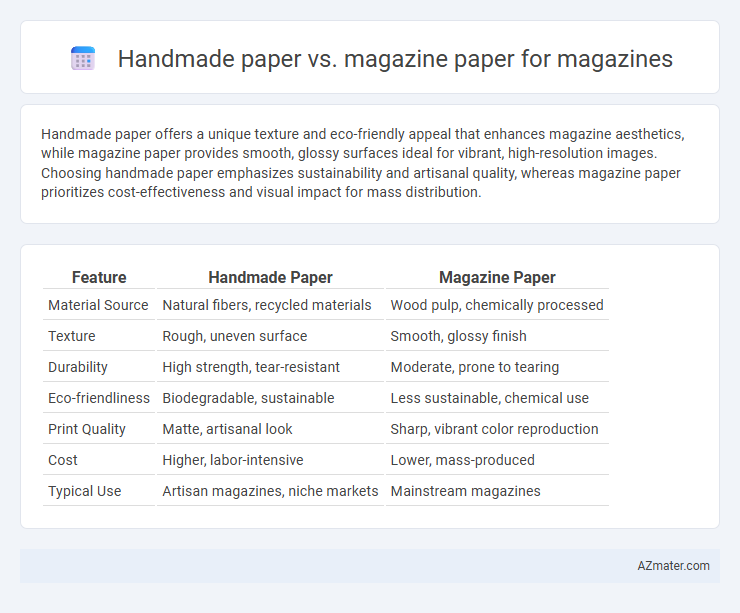Handmade paper offers a unique texture and eco-friendly appeal that enhances magazine aesthetics, while magazine paper provides smooth, glossy surfaces ideal for vibrant, high-resolution images. Choosing handmade paper emphasizes sustainability and artisanal quality, whereas magazine paper prioritizes cost-effectiveness and visual impact for mass distribution.
Table of Comparison
| Feature | Handmade Paper | Magazine Paper |
|---|---|---|
| Material Source | Natural fibers, recycled materials | Wood pulp, chemically processed |
| Texture | Rough, uneven surface | Smooth, glossy finish |
| Durability | High strength, tear-resistant | Moderate, prone to tearing |
| Eco-friendliness | Biodegradable, sustainable | Less sustainable, chemical use |
| Print Quality | Matte, artisanal look | Sharp, vibrant color reproduction |
| Cost | Higher, labor-intensive | Lower, mass-produced |
| Typical Use | Artisan magazines, niche markets | Mainstream magazines |
Introduction to Handmade Paper and Magazine Paper
Handmade paper is crafted using traditional methods involving natural fibers like cotton or hemp, resulting in a unique texture and high durability ideal for artisanal magazines. Magazine paper, typically coated and produced through industrial processes with wood pulp, offers smooth surface quality and vibrant color reproduction tailored for mass circulation. Understanding the distinct material properties and production techniques clarifies their suitability for different magazine types and target audiences.
Composition and Manufacturing Processes
Handmade paper is composed primarily of natural fibers such as cotton, hemp, or recycled textile fibers, created through a manual process involving pulping, sheet formation on a screen, and air drying, resulting in a textured and durable product. Magazine paper, also known as coated paper, consists of wood pulp combined with fillers like kaolin clay or calcium carbonate, processed through high-speed industrial machines that apply coatings to enhance gloss and printability. The manufacturing process of magazine paper emphasizes uniformity and smoothness for vibrant color reproduction, while handmade paper prioritizes artisanal quality and environmental sustainability.
Environmental Impact and Sustainability
Handmade paper offers a significantly lower environmental impact compared to magazine paper due to its use of natural fibers and minimal chemical processing, which reduces pollution and energy consumption. Magazine paper often relies on wood pulp treated with chemicals and bleaches, contributing to deforestation, higher carbon emissions, and challenges in recycling. Prioritizing handmade paper enhances sustainability by supporting eco-friendly production practices and promoting biodegradability without compromising print quality.
Texture and Aesthetic Appeal
Handmade paper offers a unique, tactile texture with natural irregularities that enhance the magazine's artisanal aesthetic, providing a sense of craftsmanship and exclusivity. Magazine paper is smooth and glossy, optimizing image sharpness and vibrant color reproduction, which appeals to mass-market publications demanding visual impact. Choosing handmade paper elevates the magazine's artistic value, while magazine paper prioritizes durability and print clarity for high-volume distribution.
Print Quality and Color Reproduction
Handmade paper offers a unique texture that enhances print quality by providing a rich, tactile experience, although it may absorb inks differently, leading to more subtle color reproduction with less vibrancy. Magazine paper, typically coated and smooth, allows for sharp image details and vibrant color reproduction due to its high gloss or satin finish, making it ideal for high-impact magazine visuals. Choosing between the two depends on whether the priority is a distinctive, artisanal feel or precise, vivid print clarity.
Durability and Longevity
Handmade paper exhibits superior durability and longevity compared to magazine paper due to its natural fibers and thicker texture, which resist tearing and yellowing over time. Magazine paper, typically coated and made with lower-quality pulp, tends to deteriorate faster, becoming brittle and fading within months of exposure to light and air. For magazines prioritizing archival quality and enduring aesthetic appeal, handmade paper offers a more sustainable and lasting choice.
Cost Comparison and Accessibility
Handmade paper commands a higher price due to labor-intensive production and limited availability, making it less accessible for large-scale magazine printing. Magazine paper, typically mass-produced from wood pulp, offers significantly lower costs and widespread accessibility, ideal for high-volume distribution. Cost-efficiency and supply consistency make magazine paper the preferred choice for mainstream magazine publishing.
Customization and Creative Flexibility
Handmade paper offers unparalleled customization with its unique textures, thickness variations, and organic fibers tailored to specific design needs, enhancing creative flexibility for artistic magazine layouts. Magazine paper, typically glossy and mass-produced, limits customization options but ensures consistent print quality and color vibrancy for high-volume publications. Choosing handmade paper elevates tactile engagement and originality, making it ideal for boutique or limited-edition magazines prioritizing artistic expression.
Reader Experience and Sensory Engagement
Handmade paper enhances reader experience by providing a tactile, textured surface that engages the senses more deeply than glossy magazine paper. Its natural fibers create a unique visual and physical appeal, offering a sense of authenticity and craftsmanship that magazine paper lacks. Magazine paper, while smoother and ideal for vibrant color reproduction, often feels less personal and can create a barrier to sensory immersion, impacting the overall engagement with the content.
Choosing the Right Paper for Your Magazine
Handmade paper offers a unique texture and eco-friendly appeal that enhances the tactile experience of high-end magazines, making it ideal for niche or artisanal publications. Magazine paper, typically coated and smooth, ensures vibrant color reproduction and durability, essential for mass-market magazines requiring sharp images and cost-effective printing. Selecting the right paper hinges on balancing aesthetic value with budget and print quality requirements to effectively engage the target audience.

Infographic: Handmade paper vs Magazine paper for Magazine
 azmater.com
azmater.com